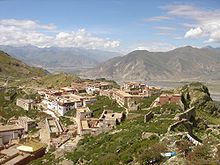Ganden monastery
| Ganden Monastery | |
|---|---|

Ganden Monastery
|
|
| Tibetan transcription(s) | |
| Tibetan | དགའ་ལྡན་ |
| Wylie transliteration | dga' ldan |
| Pronunciation in IPA | [[kàntɛ̃]] |
| Chinese transcription(s) | |
| Simplified | 甘丹寺 |
| Pinyin | Gāndān Sì |
|
|
|
| Coordinates | 29°45′28.8″N 91°28′30″E / 29.758000°N 91.47500°ECoordinates: 29°45′28.8″N 91°28′30″E / 29.758000°N 91.47500°E |
| Monastery information | |
| Location | Wangbur Mountain, Dagzê County, Lhasa Prefecture, Tibet, China |
| Founded by | Je Tsongkhapa |
| Founded | 1409 |
| Type | Tibetan Buddhist |
| Sect | Gelug |
| Dedicated to | Je Tsongkhapa |
Ganden Monastery (also Gaden or Gandain) or Ganden Namgyeling is one of the "great three" Gelug university monasteries of Tibet, China. It is in Dagzê County, Lhasa. The other two are Sera Monastery and Drepung Monastery. Ganden Monastery was founded in 1409 by Je Tsongkhapa Lozang-dragpa, founder of the Gelug order. The monastery was destroyed after 1959, but has since been partially rebuilt. Another monastery with the same name and tradition was established in Southern India in 1966 by Tibetan exiles.
Ganden is 40 kilometres (25 mi) northeast of Lhasa. The monastery lies in a hilly natural amphitheater. from the kora route around the monastery there are dramatic views over the valleys that surround it. Ganden Monastery is at the top of Wangbur Mountain, Dagzê County at an altitude of 4,300m. Its full name is Ganden Namgyal Ling (dga' ldan rmam rgyal gling). Ganden means "joyful" and is the Tibetan name for Tuṣita, the heaven where the bodhisattva Maitreya is said to reside. Namgyal Ling means "victorious temple".
Ganden Monastery was founded by Je Tsongkhapa Lozang-dragpa (1357–1419) in 1409. Tsongkhapa built Ganden's main temple, with large statues and three-dimensional mandalas. He often stayed at Ganden, and died there in 1419. Tsongkhapa's preserved body was entombed at Ganden by his disciples in a silver and gold encrusted tomb.
The name "Gelug" is an abbreviation of "Ganden Lug", meaning "Ganden Tradition". The Ganden Tripa or "throne-holder of Ganden" is the head of the Gelug school. Before dying Tsongkhapa gave his robe and staff to the first Ganden Tripa, Gyeltsabjey (1364-1432), who was succeeded by Kaydrubjey. The term of office is seven years, and by 2003 there had been 99 Ganden Tripas. The monastery was divided into four colleges at the time of the 2nd Ganden Tripa. Later these were consolidated in two, Jangtsey and Shartsey, located respectively to the north and east of the main temple. Both combine the study of sutra and tantra. Study methods include memorization, logic and debate. The colleges grant degrees for different levels of achievement, evaluated by examination and formal public debate.
...
Wikipedia

